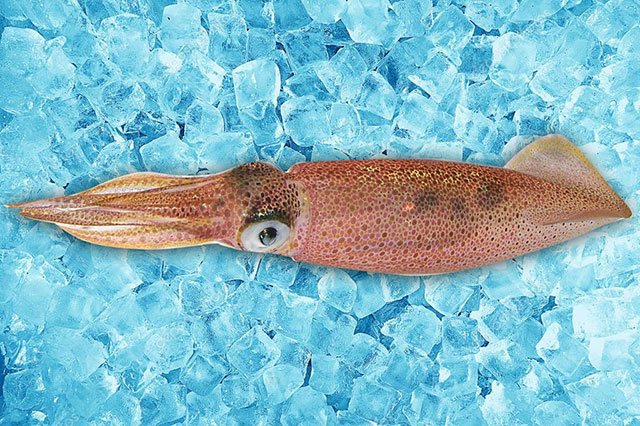
Squid Patagonica
Genus: Loligo gaht
Specification:
| Land | Packaging | *Mass | Type |
|---|---|---|---|
| Spain | Commercial | 10 kg | Cleaned |
| Spain | Bulk | 10 kg | Whole |
* Mass of goods in a transport box packaging
Doryteuthis (Logio) opalescens, the opalescent inshore squid is a small squid (mantle length (ML) up to 190 mm) in the family Loliginidae. It is a myopsid squid, which is the near shore group and that means that they have corneas over their eyes. The species lives in the eastern Pacific Ocean from Mexico's Baja California peninsula to Alaska, United States, and as an inshore squid it can be found with a range of 200 miles (320 km) off the shore
Adult Doryteuthis opalescens can reach a total size of 28 cm. Males are typically larger with a mantle length of 13-19 cm, while females are 12-18 cm in mantle length.[1] The mantle of D. opalescens is not fused to the head and its body is 4 to 5 times longer than it is wide, with fins equal in both length and width. This squid has 8 arms with 2 longer tentacles ending in tentacular clubs equipped with suckers at their ends. The tentacular clubs are narrow with 4 rows of suckers and 2 large rows in the center of the tentacular club bordered by outer rows of smaller suckers. The 8 arms have only 2 rows of alternating suckers running down their length.[2] In male D. opalescens, the left ventral arm is specialized or “hectocotylized” for spermatophore transfer during mating.[1] The eyes of D. opalescens are covered with a non-perforated membrane known as a cornea which is a signature of myopsid squid.[1] The color of D. opalescens can range from white to brown, with the animals able to change their color shades using chromatophores depending on mood and for camouflage. They are normally a bluish-white to mottled brown and gold, and they change to dark red or brown when excited, frightened or feeding.[1]
Habitat
The life cycle of D. opalescens has four stages: eggs, hatchlings (called paralarvae), juveniles, and adults. Squid live for 6–9 months. Doryteuthis opalescens eggs are laid on sandy bottom substrates in 10–50 m depth, although there is a report of a shrimp trawler pulling up eggs from 400 fathoms (730 m). Females encapsulate hundreds of eggs in a sheath that is made of many layers of protein. Bacteria grow between the layers and may serve as an antibiotic for fungal infection. Females insert the egg capsules into the sand with a sticky substance that anchors them in place so that the ocean surge can ventilate them. The presence of eggs on the bottom of tanks stimulates females to lay more eggs. Groups of capsules are placed in masses that can extend into egg beds. Some egg beds can cover acres of the ocean floor. The eggs take 3-8 weeks to hatch with warmer water shortening the incubation time. Bat stars (Asterina miniatus) are the most prevalent predators of eggs. Fish do not eat them, although they will nip at eggs not covered by the capsule sheath. There is no brooding.
Paralarvae of D. opalescens hatch from the eggs and immediately begin swimming. Where they go is unknown, but hatchlings of the closely related Loligo pealei swim to the surface in the first 12 hours post-hatching. Paralarvae must rapidly learn to hunt, as their yolk is either used up or detached upon escaping from the egg sheath. Through a series of trial and error as these 2–3 mm ML hatchlings learn to eat copepods and other plankton in the first months of their lives. They are found in the greatest abundance at 15 m depth by night and 30 m depth by day. Thus, they perform a daily vertical migration of 15 meters, no small feat a creature only 3 mm long. This daily migration coupled with the shear zone created by tidal and near-shore currents cause the hatchlings to become entrained within 3 kilometers of shore. That is good for them because in the near-shore environment the plankton is smaller and easier for them to eat.
BACKStanište lignje je širom Sredozemnog mora, u vodama istočnog Atlantika od Severnog mora do Gvinejskog zaliva. Vrlo je česta i zalazi čak do dubina od 400 metara, a u pliće vode izlazi u vreme mrešćenja. Prosečna dubina na kojoj se ova vrsta lignje kreće je između 50 i 100 metara. Lignjama je najčešće stanište iznad peščanog ili peščano-muljevitog morskog dna.
nazad